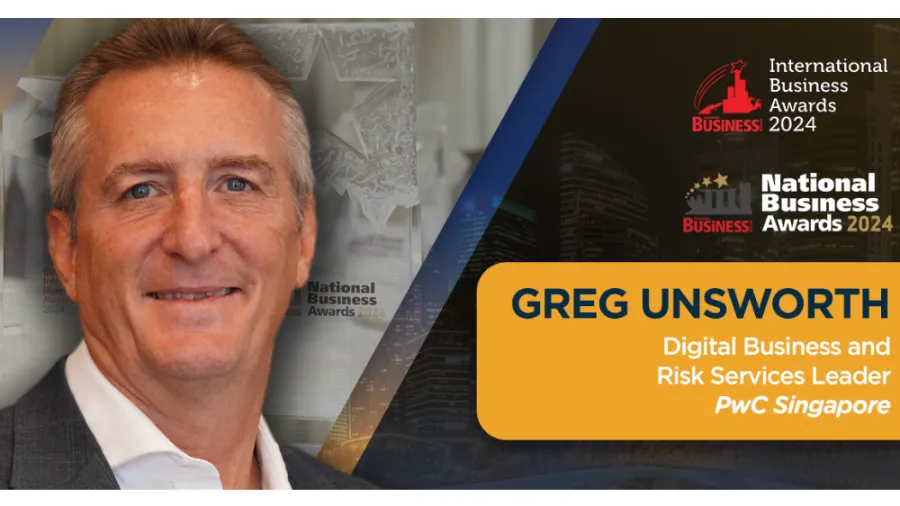
PwC's Greg Unsworth offers insights into evolving business landscape: Navigating digital transformation, risk, and sustainability
Delve into his unique perspective on navigating the complexities of today's fast-paced business environment.
The dynamic business landscape in Singapore and the broader Southeast Asian region is undergoing significant transformations, driven by digitalisation, risk management challenges, and sustainability imperatives.
Greg Unsworth is currently leading PwC Singapore's Digital Business and Risk Services practice. Overseeing a team of 20 partners and 400 professionals, Unsworth focuses on helping clients navigate business risks, enhance governance, comply with regulations, and build digital trust. He is part of the firm's Leadership Team and he contributes significant expertise to advise clients on digital business initiatives and risk management.
Instrumental in establishing PwC Singapore's "Reimagine Digital" programme, Unsworth leads efforts to transform service delivery through technology platforms, foster talent capability, and invest in key digital assets, including AI-enabled business and aligning with smart nation imperatives. As a member of global advisory and editorial committees, he actively contributes to shaping the industry's thought leadership.
With his extensive background in guiding clients through digital business initiatives and managing risks, Unsworth offers valuable insights into the trends, strategies, and challenges shaping the region's corporate environment.
In this exclusive interview, Unsworth shares his perspectives on the current state of the business landscape in Singapore and Southeast Asia, emphasising digital transformation, risk management, and sustainability. The conversation delves into key trends, strategies for effective risk management, critical sustainability challenges and opportunities, and practical advice for businesses embarking on digital transformation journeys.
Can you share some key trends and developments that are shaping the business landscape in Singapore and the broader Southeast Asian region, particularly in relation to digital transformation and risk management?
In Singapore and Southeast Asia, many business leaders we speak with are taking a relatively cautious approach to growth plans in the short-term as they contend with inflationary pressure, higher interest rates, and broader economic and geopolitical uncertainty. However, when taking a longer-term view, many leaders are assessing and developing radical plans to reinvent their business models, embrace technology in new and more significant ways, and prepare for an AI-enabled business future.
Whilst there is a growing awareness of risks that are unique to AI and emerging technologies, risk functions are still looking to embrace these very same technologies to carry out their risk management activities more efficiently and effectively. As a result, more technology-driven risk management solutions are being marketed and commercialised, and will be an area of growth for technology vendors in the future.
What strategies and best practices have you observed that organisations are adopting to effectively manage business risks, enhance governance, and build digital trust in today's fast-paced business environment?
In both regulated and increasingly, non-regulated industry sectors, there are a few key strategies and best practices that are being applied in practice by business leaders, including:
● Holistic risk management – businesses are taking an organisation-wide view of risk rather than assessing and managing risk in silos. This is not new but is growing in prevalence, driven by more wary and attentive board members and stakeholders as they seek greater assurances in a highly volatile business environment.
● Trust by design – rather than risk management being an afterthought, leading organisations are building robust risk management and control principles at the outset for all significant new systems or change initiatives. This helps businesses better anticipate, mitigate and manage risks associated with new ventures and business programmes.
● Embracing technology platforms and solutions – this will help empower risk practitioners to manage risks more efficiently and with a greater degree of precision and rigour. Additionally, AI technologies are also unlocking greater opportunities to develop better predictive capabilities to address future emerging risk factors.
What do you see as the most critical sustainability challenges and opportunities for businesses in Singapore, and how can organisations integrate sustainable practices into their day-to-day operations whilst maintaining profitability?
Sustainability and broader ESG principles are at the top of the agenda for boards and business leaders across the region and globally. Some of the most critical challenges that organisations are contending with include:
● Strategic planning - this involves developing a longer-term strategic view and plans towards net zero or other specific emission reduction objectives. It also entails developing a roadmap to achieve these in a feasible and predictable manner.
● Addressing stakeholder expectations – employees, customers, suppliers, regulators, and the wider community are all raising their expectations of organisations. This often creates tension for businesses to navigate between short-term profitability objectives and longer-term sustainable practice goals.
● Measuring and reporting climate impact – regulatory and sustainability reporting standards are still being developed, and in some cases, different frameworks and standards being promoted globally are not consistent. This creates challenges and complexities for business leaders to capture the right and relevant data, measure impact accurately, and report progress externally in a meaningful, consistent, and understandable way.
● Upskilling the workforce – in the future, sustainable practices will need to be embedded in everything an organisation does. It is a dual imperative for organisations to increasingly educate and upskill the entire workforce so they are well-equipped to operate effectively in the future.
Despite these challenges, there are opportunities for organisations that can embrace sustainable practices effectively. This opens doors for them to build new product and service offerings, access finance and funding more efficiently, and develop broader trust with investors, communities, and regulators. Such efforts will enable businesses to operate with more confidence and garner broader stakeholder support.
Given your experience advising clients on digital business initiatives, what advice do you have for businesses looking to embark on digital transformation journeys? What are the common pitfalls to avoid, and what steps can they take to ensure a successful digital transformation?
First and foremost, start with the business mission. Technology should be used to enhance and help business leaders achieve their business missions, not the other way around. For business leaders, it’s about understanding the possibilities of the new technology in helping them achieve their mission and not getting too distracted by the most recent “shiny new object”. Once the future business mission is clear, it is important to develop a target operating business model needed to bring it to life. Whilst developing this model, there is an opportunity to assess how technology can help ensure it is as effective, efficient, and impactful as possible.
In executing any major digital transformation, there are a number of key success factors, including:
● Implementing effective change management strategies, maintaining constant communication and engaging stakeholders;
● Conducting rigorous cost/benefit analyses with project performance monitoring;
● Establishing effective risk management controls from the outset and maintaining a continuous risk monitoring programme;
● Deploying the right resources, including partnering with others outside the organisation where appropriate;
● Investing in upskilling and training, and empowering the workforce to embrace newly deployed technologies
With your involvement in various global and regional industry networks, can you provide some insights into the importance of building international relationships and collaborations in today's business landscape?
We are currently operating in a very uncertain economic and geopolitical environment where previously accepted global norms are being regularly tested. In this environment, it is even more of a business imperative to build international networks and connections to better understand the risks associated with operating in different markets, as well as to capture new opportunities in a fast-changing landscape.
These networks can also help businesses tap into additional valuable capabilities and knowledge and secure new partnerships for growth.
In your role as a judge at the SBR National Business Awards and International Business Awards, what specific criteria and attributes do you look for when evaluating companies for recognition?
Beyond the impressive business performance and outcomes that will undoubtedly be on display, I look forward to really good examples of business leadership, especially in managing adversity and innovation to shape future industry development.



![SBR 5 Lorem Ipsum News 2 [8 May]](https://cmg-qa.s3.ap-southeast-1.amazonaws.com/s3fs-public/styles/exclusive_featured_article/public/2025-05/a_hand_pointing_to_a_futuristic_technology_5b87c9d0e3_3.png.webp?itok=M3Hf-9XR)
![SBR 4 Lorem Ipsum [8 May Top Stories]](https://cmg-qa.s3.ap-southeast-1.amazonaws.com/s3fs-public/styles/exclusive_featured_article/public/2025-05/a_hand_pointing_to_a_futuristic_technology_5b87c9d0e3_2.png.webp?itok=2m5Wl0MX)


![Exclusive three SBR 12 Lorem Ipsum [8 May]](https://cmg-qa.s3.ap-southeast-1.amazonaws.com/s3fs-public/styles/exclusive_featured_article/public/2025-05/a_hand_pointing_to_a_futuristic_technology_5b87c9d0e3_11.png.webp?itok=8kn_UIfA)
![SBR 3 Lorem Ipsum [ Exclusive 2]](https://cmg-qa.s3.ap-southeast-1.amazonaws.com/s3fs-public/styles/exclusive_featured_article/public/2025-05/a_hand_pointing_to_a_futuristic_technology_5b87c9d0e3_1.png.webp?itok=YCyjLegJ)
![SBR 2 Lorem Ipsum [8 May]](https://cmg-qa.s3.ap-southeast-1.amazonaws.com/s3fs-public/styles/exclusive_featured_article/public/2025-05/a_hand_pointing_to_a_futuristic_technology_5b87c9d0e3_0.png.webp?itok=_cKD-29o)

![Video [Event News]](https://cmg-qa.s3.ap-southeast-1.amazonaws.com/s3fs-public/styles/event_news_featured_article/public/2025-05/screenshot-2025-05-08-at-4.58.53-pm_0.png.webp?itok=Kud35sMs)
![Event News SBR 9 Lorem Ipsum [8 may]](https://cmg-qa.s3.ap-southeast-1.amazonaws.com/s3fs-public/styles/event_news_thumbnail/public/2025-05/a_hand_pointing_to_a_futuristic_technology_5b87c9d0e3_8.png.webp?itok=DTh_dbYp)
![Event News SBR 9 Lorem Ipsum [8 May]](https://cmg-qa.s3.ap-southeast-1.amazonaws.com/s3fs-public/styles/event_news_thumbnail/public/2025-05/a_hand_pointing_to_a_futuristic_technology_5b87c9d0e3_7.png.webp?itok=vzDAzb6V)
![Event News SBR 8 Lorem Ipsum [8 May]](https://cmg-qa.s3.ap-southeast-1.amazonaws.com/s3fs-public/styles/event_news_thumbnail/public/2025-05/a_hand_pointing_to_a_futuristic_technology_5b87c9d0e3_6.png.webp?itok=jvHFc4P6)
![Video [Event News]](https://cmg-qa.s3.ap-southeast-1.amazonaws.com/s3fs-public/styles/video_thumbnail/public/2025-05/screenshot-2025-05-08-at-4.58.53-pm_0.png.webp?itok=yZnI0YBb)
![Video 1 SBR [8 May]](https://cmg-qa.s3.ap-southeast-1.amazonaws.com/s3fs-public/styles/video_thumbnail/public/2025-05/screenshot-2025-05-08-at-4.58.53-pm.png.webp?itok=9AAeRz_k)

 Advertise
Advertise

